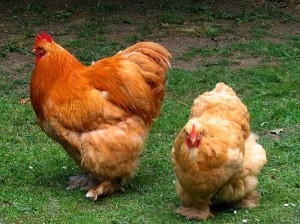The benefits of raising dual-purpose chickens
 Compromise is often a bad thing but in the case of dual-purpose chickens it is a sensible and practical idea for the home flock. There is nothing more satisfying than watching a flock of robust hens roaming about the farm chasing butterflies in late summer or sucking up earthworms after a rain. They are inexpensive to purchase, reasonable to maintain, and fun to watch. In return you are rewarded with eggs that have bright orange stand-up yolks and a freezer stocked with fryers and roasters that you know were organically grown in a natural environment.
Compromise is often a bad thing but in the case of dual-purpose chickens it is a sensible and practical idea for the home flock. There is nothing more satisfying than watching a flock of robust hens roaming about the farm chasing butterflies in late summer or sucking up earthworms after a rain. They are inexpensive to purchase, reasonable to maintain, and fun to watch. In return you are rewarded with eggs that have bright orange stand-up yolks and a freezer stocked with fryers and roasters that you know were organically grown in a natural environment.
*The Compromise
For an excellent egg producer there are several production breeds available but they tend to be scrawny and would make a lousy meat bird. Likewise, there are some amazing meat chickens but their egg-laying ability has been sacrificed in the intensive breeding for feed to weight conversion ratios. This is where the dual-purpose chicken comes in. It is not the best in either category but quite acceptable in both. I have found them to be healthier overall and more “normal” in chicken behavior than some of the highly bred production breeds. This is an ideal solution for a family wishing to supply their own needs and to make a small income selling eggs to the community.
*The Breeds
The best breeds for the dual-purpose flock are generally from the American Class. This class includes the Delaware, Rhode Island Red, Plymouth Barred Rock and New Hampshire. I’ve also had great success with Orpingtons, Australorps and some White Rocks for continuous winter laying. These all lay brown eggs. Pick a few from several different breeds and see what works best for you.
*Getting Off to a Good Start
There are different ways to start your first flock.
1. You can purchase grown hens from someone who has a surplus. This can be the most expensive option since the hens are already laying. You need to be able to trust this person’s word that the chickens are not older than advertised. After the first two years a hen’s egg production will drop off dramatically and at this age the only meat option is chicken soup. Another concern getting birds from another farm is the spread of disease.
2. A cheaper option is to buy fertile eggs from a mail-order company or the farmer down the road. It is exciting for kids to watch the eggs in an incubator and take the responsibility of caring for them for the 21 days they take to hatch. You need to remember the hatch rate in the typical home incubator is about 50% and the rooster rate is also 50%! So with 20 eggs you can expect to end up with 5 hens. Of course these extra roosters are perfect for your meat birds to be slaughtered at 8-16 weeks depending on the breed. You should only start your flock this way if you know the eggs are purebred. Cross-bred hens will not lay as well as the original parents.
3. The final option is to buy day-old chicks (peeps) from your local farm store or mail-order company. They ship very well through the mail. The mail-order companies give you a tremendous selection from which to choose whereas the farm store will offer the choice of two or three production breeds. You can choose pullets or cockerels. If you don’t choose it is called “straight-run”. This is the cheapest option and then you can eat the excess roosters and keep the hens for laying. Roosters are not necessary for hens to lay eggs, only for hens to lay fertilized eggs.
Having a flock of dual-purpose chickens is a good, common-sense addition to any homestead. They supply the owner with eggs and meat, not to mention bug control, rich manure and general entertainment. Raising them keeps alive the breeds that are being neglected for more efficient single-purpose factory production breeds. In a time when faster, bigger, more is always better, the old-fashioned dual-purpose chicken stands out as an exception that wins all around.
|
|
Article is courtesy of Julie Helms
Twitter: @julie_helms |
Add a Comment
You must be logged in to post a comment.


I agree, dual purpose is the way to go. I raised Cornish Cross, a meat breed, because they were given away for free at the feed store. What a horribly inhumane frankenbird! Poor things.